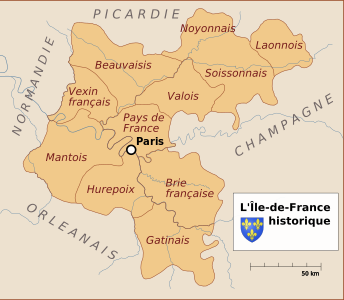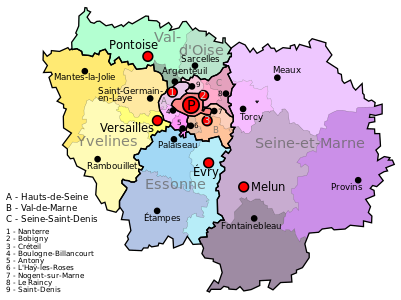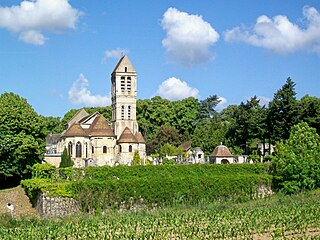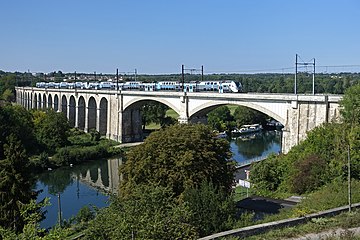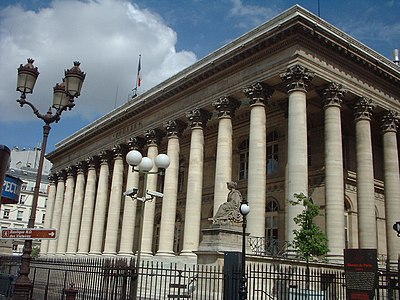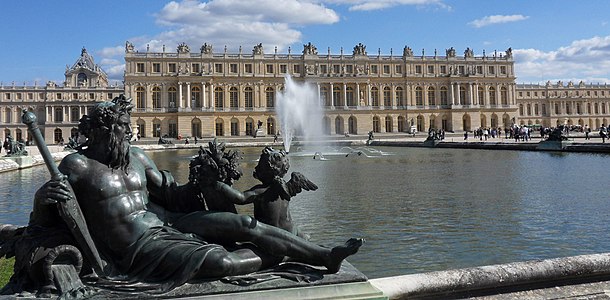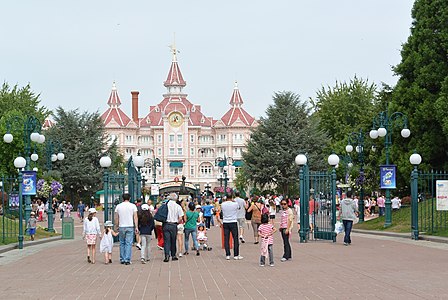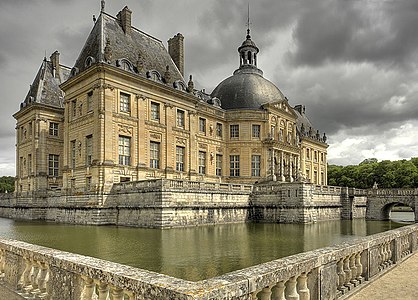Île-de-France
Île-de-France | |
|---|---|
Clockwise from top:westernParisandLa Défensein the distance; the Viaduc ofSaint-Mammès;thePalace of Versailles;and theUNESCO World Heritage SiteofProvins | |
 Interactive map of Île-de-France | |
 | |
| Country | France |
| Prefecture | Paris |
| Departments | 8
|
| Government | |
| •President of the Regional Council | Valérie Pécresse(LR) |
| Area | |
| • Total | 12,012 km2(4,638 sq mi) |
| • Rank | 13th |
| Population (1 January 2023) | |
| • Total | 12,271,794[1] |
| • Density | 1,022/km2(2,650/sq mi) |
| Demonym | French:Francilien |
| GDP | |
| • Total | €782.639 billion (2022) |
| Time zone | UTC+01:00(CET) |
| • Summer (DST) | UTC+02:00(CEST) |
| ISO 3166 code | FR-IDF |
| NUTS Region | FR1 |
| Website | www |
TheÎle-de-France(/ˌiːldəˈfrɒ̃s/,French:[ildəfʁɑ̃s];lit. 'Island of France') is the most populous of the eighteenregions of France,with an official estimated population of 12,271,794 residents on 1 January 2023.[1]Centred on the capitalParis,it is located in the north-central part of the country and often called theParis Region[3](French:Région parisienne,pronounced[ʁeʒjɔ̃paʁizjɛn]). Île-de-France is densely populated and retains a prime economic position on the national stage, but it covers only 12,012 square kilometres (4,638 square miles), about 2% ofmetropolitan French territory.Its 2017 population was nearly one-fifth of the national total.[4]
The region is made up of eight administrativedepartments:Paris,Essonne,Hauts-de-Seine,Seine-Saint-Denis,Seine-et-Marne,Val-de-Marne,Val-d'OiseandYvelines.It was created as the "District of the Paris Region" in 1961. In 1976, when its status was aligned with the French administrative regions created in 1972, it was renamed after the historic province of Île-de-France. Residents are sometimes referred to asFranciliens,an administrative word created in the 1980s. The GDP of the region in 2019 was nearly one-third of the French,[5]: 12 and 5% of the European Union's.[5]: 12 It has the highest per capita GDP of any French region.[6]
Beyond the city limits of Paris, the region has many other important historic sites, including the palaces ofVersaillesandFontainebleau,as well as the most-visited tourist attraction in France,Disneyland Paris.Although it is the richest French region, a significant number of residents live in poverty. The official poverty rate in the Île-de-France was 15.9% in 2015. The region has witnessed increasing income inequality in recent decades, and rising housing prices have pushed the less affluent outside Paris.[7]
Etymology[edit]
Although the modern name Île-de-France literally means Island of France, its etymology is unclear. The "island" may refer to the land between the riversOise,MarneandSeine,or it may also have been a reference to theÎle de la Cité,where the French royal palace and cathedral were located.[citation needed]
Alternatively, the name may refer to thelands that were under the direct ruleof theCapetian kingsduring theMiddle Ages;thus, the lands were an "island" in a sea of variousfeudal territoriesruled byvassalsof the king.[8]
Departments[edit]
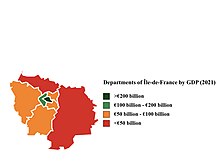
| Department | Area km2 | Population | GDP[9] | GDP per capita |
|---|---|---|---|---|
| 105 | 2,133,111 | €253.101 billion | €118,653 | |
| 176 | 1,635,291 | €188.333 billion | €115,168 | |
| 236 | 1,668,670 | €66.227 billion | €39,688 | |
| 245 | 1,415,367 | €56.818 billion | €40,144 | |
| 1,246 | 1,256,607 | €38.861 billion | €30,925 | |
| 5,915 | 1,438,100 | €42.983 billion | €29,889 | |
| 1,804 | 1,313,768 | €58.462 billion | €44,500 | |
| 2,284 | 1,456,365 | €60.058 billion | €42,238 | |
| Île-de-France | 12,012 | 12,317,279 | €764.844 billion | €62,095 |
History[edit]
-
Historic province of Île-de-France before theFrench Revolution
-
The modern départements covered by the historical Île-de-France
-
Modern region of Île-de-France and départements
The Île-de-France was inhabited by theParisii,a sub-tribe of theCelticSenones,from around the middle of the 3rd-century BC.[10][11]One of the area's major north–south trade routes crossed the Seine on theîle de la Cité;the meeting place of land and water trade routes gradually became an important trading centre.[12]The Parisii traded with many river towns (some as far away as the Iberian Peninsula) and minted their own coins for that purpose.[13]
TheRomansconquered the area in 52 BC and began their settlement on Paris'sLeft Bank.[14]It became a prosperous city with a forum, baths, temples, theatres, and an amphitheatre.[15]Christianitywas introduced in the middle of the 3rd century AD bySaint Denis,the first Bishop of Paris. According to legend, when Denis refused to renounce his faith before Roman authorities, he was beheaded on the hill that became known asMons Martyrum(Latin "Hill of Martyrs" ), later "Montmartre".The legend further states that Denis walked headless from this hill to the north of the city. The place that he finally fell and was buried became an important religious shrine, theBasilica of Saint-Denis.[16]
Clovis the Frank,the first king of theMerovingian dynasty,made the city his capital in 508. As the Frankish domination of Gaul began, there was a gradual immigration by theFranksto Paris and the ParisianFranciendialects were born. Fortification of the Île de la Cité failed to avertsacking by Vikings in 845,but Paris's strategic importance—with its bridges preventing ships from passing—was established by successful defence in theSiege of Paris (885–86).In 987,Hugh Capet,Count of Paris(comte de Paris) andDuke of the Franks(duc des Francs), was electedKing of the Franks(roi des Francs). Under the rule of theCapetiankings, Paris gradually became the largest and most prosperous city in France.[16]
The Kings of France enjoyed getting away from Paris and hunting in the game-filled forests of the region. They built palatial hunting lodges, most notablyPalace of Fontainebleauand thePalace of Versailles.From the time of Louis XIV to the French Revolution, Versailles was the official residence of the Kings and the seat of the French government. Île-de-France became the term used for the territory of Paris and the surrounding province, which was administered directly by the King.
During theFrench Revolution,the royal provinces were abolished and divided into departments, and the city and region were governed directly by the national government. After World War II, as Paris faced a major housing shortage, hundreds of massive apartment blocks for low-income residents were built around the edges of Paris. In the 1950s and the 1960s, thousands of immigrants settled in the communes bordering the city. In 1959, under PresidentCharles De Gaulle,a new region was created out of six departments, which corresponded approximately with the historic region, with the nameDistrict de la région de Paris( "District of the Paris Region" ). On 6 May 1976, as part of the process ofregionalisation,the district was reconstituted with increased administrative and political powers and renamed the Île-de-France region.
Geography[edit]
Île-de-France is in the north of France, neighboringHauts-de-Franceto the north,Grand Estto the east,Bourgogne-Franche-Comtéto the southeast,Centre-Val-de-Loireto the southwest, andNormandyto the west.
-
View of theforest of FontainebleauinSeine-et-Marne
-
TheSeinein Paris
-
Vineyard inLuzarches,Val-d'Oise
Departments[edit]
Île-de-France has a land area of 12,011 km2(4,637 sq mi). It is composed of eightdepartmentscentred on its innermost department and capital, Paris. Around the department and municipality of Paris, urbanisation fills a first concentric ring of three departments commonly known as thepetite couronne( "small ring" ); it extends into a second outer ring of four departments known as thegrande couronne( "large ring" ). Theformer department of Seine,abolished in 1968, included the city proper and parts of thepetite couronne.
Thepetite couronneconsists of the departments ofHauts-de-Seine,Seine-Saint-DenisandVal-de-Marne;thegrande couronneconsists of those ofSeine-et-Marne,Yvelines,EssonneandVal-d'Oise.Politically, the region is divided into 8 departments, 25 arrondissements, 155 cantons and 1,276 communes, out of the total of 35,416 inmetropolitan France.[4]
Topography[edit]
The outer parts of the Île-de-France remain largely rural. Agricultural land, forest and natural spaces occupy 78.9 percent of the region, and 28 percent of the region's land is in urban use.[17]
The RiverSeineflows through the middle of the region, which is crisscrossed by its tributaries and sub-tributaries, including the RiversMarne,OiseandEpte.The RiverEuredoes not cross the region but receives water from several rivers in the Île-de-France, including the Drouette and the Vesgre. The major rivers are navigable, and, because of the modest variations of altitude in the region (between 10 metres (33 ft) and 200 metres (660 ft)), they have a tendency to meander and curve. They also create many lakes and ponds, some of which have been transformed into recreation areas, including Moisson-Mousseaux, Cergy-Neuville andVilleneuve-Saint-Georges.
Economy[edit]

Paris region (Île-de-France) produced €742 billion (Gross domestic product)[5]or around 1/3 of theeconomy of Francein 2019.[5]: 12
The regional economy has gradually shifted toward high-value-added service industries (finance, IT services, etc.) and high-tech manufacturing (electronics, optics, aerospace, etc.).[19]In 2014, industry represented just under five percent of active enterprises in the region, and 10.2 percent of salaried workers. Commerce and services account for 84 percent of the business establishments in the region, and have 83.3 percent of the salaried employees.[20]
Financial services and insurance are important sectors of the regional economy; the major French banks and insurance companies, includingBNP Paribas,Société Générale,andCrédit Agricole,all have their headquarters in the region. The region also hosts the headquarters of the top French telecom companies and utilities, includingOrange S.A.,Veolia,andEDF.The French stock market, theBourse de Paris,now known asEuronext Paris,occupies a historical building in the center of Paris and is ranked fourth among global stock markets, after New York, Tokyo and London.[21]
Other major sectors of the regional economy include energy companies (Orano,Engie,Électricité de France,andTotal S.A.). The two major French automobile manufacturers,RenaultatFlins-sur-SeineandGroupe PSAatPoissy,do much of their assembly work outside of France but still have research centre and large plants in the region. The leading French and European aerospace and defense companies, includingAirbus,Thales Group,Dassault Aviation,Safran Aircraft Engines,theEuropean Space Agency,Alcatel-Lucent,andArianespace,have a large presence in the region.[21]
The energy sector is also well established in the region. The nuclear power industry, with its major firmOrano,has its headquarters in Île-de-France, as does the main French oil companyTotal S.A.,the top French company in the Fortune Global 500, and the main electric utility,Électricité de France.The energy firmEngiealso has its main offices in the region atLa Défense.
-
Headquarters ofTotalinLa Défense
-
The historic Bourse de Paris, or Paris stock market, now calledEuronext Paris
-
Headquarters ofSociété GénéraleinLa Défense
Employment[edit]
In 2018 just 7.2 percent of employees in the region were engaged in industry; 62.3 percent were engaged in commerce and market services; 25.5 percent in non-market services, including government, health and education; 4.8 percent in construction; and 0.2 percent in agriculture.[22]
The largest non-government employers in the region as of the end of 2015 were the airlineAir France(40,657); theSNCF(French Railways, 31,955); the telecom firmOrange S.A.(31,497); the bankSociété Générale(27,361); the automotive firmGroupe PSA(19,648);EDF(Electricité de France, 18,199); andRenault(18,136).[23]While the Petite Couronne, or departments closest to Paris, previously employed the most industrial workers, the largest number is now in the Grande Couronne, the outer departments.[22]
The unemployment rate in the region stood at 8.6% at the end of 2016. It varied within the region from 7.8 percent in the city of Paris, to a high of 12.7 percent inSeine-Saint-Denis,and 10 percent inVal-d'Oise;to regional lows of 7.4 percent inYvelines;7.5 percent inHauts-de-Seine;7.7 percent inEssonne;7.9 percent inSeine et Marne,and 8.8 percent inVal de Marne.[24]
Agriculture[edit]
In 2018, 48 percent of the land of the Île-de-France was devoted to agriculture; 569,000 hectares were cultivated. The most important crops are grains (66 percent), followed by beets (7 percent), largely for industrial use, and grass for grazing. In 2014, 9,495 hectares were devoted to bio-agriculture. However, the number of persons employed in agriculture in the region dropped 33 percent between 2000 and 2015 to just 8,460 persons in 2015.[25]
Tourism[edit]
The Île-de-France is one of the world's top tourist destinations, with a record 23.6 million hotel arrivals in 2017, and an estimated 50 million visitors in all types of accommodation. The largest number of visitors came from the United States, followed by England, Germany and China.[26] [27][28]The top tourist attraction in the region in 2017 wasDisneyland Paris,which received 14.8 million visitors in 2017, followed by theCathedral of Notre-Dame(est. 12 million) and theBasilica of Sacre-Coeurat Montmartre (est. 11.1 million visitors).[29]
-
Notre-Dame Cathedral(12 million visitors in 2017)
-
Palace of Versailles(7.7 million visitors in 2017)
-
Disneyland Paris(14.8 million visitors in 2017)
Notable historic monuments in the Region outside of Paris include thePalace of Versailles(7,700,000 visitors), thePalace of Fontainebleau(500,000 visitors), the chateau ofVaux-le-Vicomte(300,000 visitors), and theChâteau de Malmaison,Napoleon's former country house; and theBasilica of Saint-Denis,where the Kings of France were interred before theFrench Revolution.[30]
Regional government and politics[edit]

The Regional Council is the legislative body of the region. Its seat is inSaint-Ouen-sur-Seine,at 2 rue Simone-Veil. On 15 December 2015, a list of candidates of the Union of the Right, a coalition of centrist andright-wingparties, led byValérie Pécresse,narrowly won the regional election, defeating the Union of the Left, a coalition of socialists and ecologists. The socialists had governed the region for the preceding 17 years.
Since 2016 the regional council has 121 members from the Union of the Right, 66 from the Union of the Left and 22 from thefar-rightNational Front.[31]
Holders of the executive office[edit]
- Delegates General for the District of the Paris Region
- 1961–1969:Paul Delouvrier(civil servant) – Very influential term. Responsible for the creation of theRERexpress subway network in the Île-de-France and beyond.
- 1969–1975: Maurice Doublet (civil servant)
- 1975–1976: Lucien Lanier (civil servant)
- Presidents of the Regional Council of Île-de-France
- 1976–1988:Michel Giraud(RPRpolitician) – (1st time)
- 1988–1992: Pierre-Charles Krieg (RPRpolitician)
- 1992–1998:Michel Giraud(RPRpolitician) – (2nd time)
- 1998–2015:Jean-Paul Huchon(PS)
- 2016–Valérie Pécresse(Union of the Centre-Right)
Demographics[edit]

Population density[edit]
As of 1 January 2017[update],the population density of the region was 1010.9 inhabitants per square kilometer. The densest department is Paris itself, with 21,066 inhabitants per square kilometer. The least dense département isSeine-et-Marnewith 239 residents per square kilometer.[32]
Wealth and poverty[edit]
As of 2015[update]according to the official government statistics agency INSEE, 15.9 percent of residents of the region had an income below the poverty level; for residents of the city of Paris, this proportion was 16.2 percent. Poverty was highest in the departments ofSeine-Saint-Denis(29 percent),Val-d'Oise(17.1 percent), andVal-de-Marne(16.8 percent). It was lowest inYvelines(9.7 percent);Seine-et-Marne(11.8 percent),Essonne(12.9 percent), andHauts-de-Seine(12.4 percent). The department of Hauts-de-Seine is the wealthiest in France in terms of per capita GDP.[33]
Immigration[edit]
| 2019 Census Paris Region | |||||||||||||||||||||||||||||||||||||||||
|---|---|---|---|---|---|---|---|---|---|---|---|---|---|---|---|---|---|---|---|---|---|---|---|---|---|---|---|---|---|---|---|---|---|---|---|---|---|---|---|---|---|
| (Île-de-France)[34][35] | |||||||||||||||||||||||||||||||||||||||||
| |||||||||||||||||||||||||||||||||||||||||
| |||||||||||||||||||||||||||||||||||||||||
At the 2019 census, 75.1% of the inhabitants of Île-de-France were natives ofMetropolitan France,1.7% were born inOverseas France,and 23.1% were born in foreign countries.[36]A quarter of the immigrants living in the Île-de-France were born in Europe (38% of whom in Portugal), 29% were born in theMaghreband 22% in the rest of Africa (in particularWestandCentral Africa), 3% were born in Turkey and 15% in the rest of Asia, 5% were born in the Americas (not counting those born in theFrench overseas departmentsin the Americas, who are not legally immigrants), and 0.1% in Oceania (not counting those born in the French territories of the South Pacific, who are not legally immigrants).[37]
In 2013, roughly 2,206,000 residents of the Île-de-France were immigrants, born outside of France. This amounted to 18.5% of the population of the region, twice the national average. Four out of ten immigrants living in France reside in the region. The immigrant population of the Île-de-France has a higher proportion of non-Europeans, as well as a higher proportion of immigrants with an advanced level of education, than the rest of France. The population of immigrants is more widely distributed throughout the region than it was in the early 2000s, but the concentrations remain high in certain areas, particularly Paris and the department of Seine-Saint-Denis. The proportion of residents born outside of Metropolitan France rose between the 1999 (19.7%) and 2019 censuses (24.9%).[38][36]
| Census | Born in Metropolitan France |
Born in Overseas France |
Born in foreign countries with French citizenship at birth[a] |
Immigrants[b] | |||||
|---|---|---|---|---|---|---|---|---|---|
| 2019 | 75.1% | 1.7% | 3.4% | 19.8% | |||||
| from Europe | from the Maghreb[c] | from Africa (excl. Maghreb) | |||||||
| 5.0% | 5.8% | 4.4% | |||||||
| from Turkey | from Asia (excl. Turkey) | from the Americas & Oceania | |||||||
| 0.6% | 3.0% | 1.1% | |||||||
| 2013 | 76.3% | 1.7% | 3.5% | 18.5% | |||||
| from Europe | from the Maghreb[c] | from Africa (excl. Maghreb) | |||||||
| 5.0% | 5.4% | 3.8% | |||||||
| from Turkey | from Asia (excl. Turkey) | from the Americas & Oceania | |||||||
| 0.6% | 2.8% | 1.0% | |||||||
| 2008 | 77.4% | 1.7% | 3.5% | 17.4% | |||||
| from Europe | from the Maghreb[c] | from Africa (excl. Maghreb) | |||||||
| 4.9% | 5.1% | 3.3% | |||||||
| from Turkey | from Asia (excl. Turkey) | from the Americas & Oceania | |||||||
| 0.6% | 2.5% | 0.9% | |||||||
| 1999 | 80.3% | 1.8% | 3.2% | 14.7% | |||||
| 1990 | 80.4% | 1.9% | 3.7% | 14.0% | |||||
| 1982 | 81.1% | 1.7% | 3.9% | 13.3% | |||||
| 1975 | 82.9% | 1.0% | 3.9% | 12.2% | |||||
| 1968 | 85.3% | 0.5% | 4.0% | 10.2% | |||||
| ^aPersons born abroad of French parents, such asPieds-Noirsand children of French expatriates. ^bAn immigrant is by French definition a person born in a foreign country and who did not have French citizenship at birth. An immigrant may have acquired French citizenship since moving to France, but is still listed as an immigrant in French statistics. On the other hand, persons born in France with foreign citizenship (the children of immigrants) are not listed as immigrants. ^cMorocco, Tunisia, Algeria | |||||||||
| Source: INSEE[36][37][38][39][40] | |||||||||
Petite Couronne[edit]
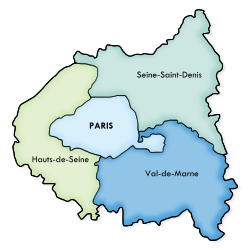

ThePetite Couronne[41](literally "Little Crown" or inner ring) is formed by the threedepartmentsbordering Paris, forming a geographicalcrownaround it. These departments, until 1968 part of the disbandedSeinedepartment, areHauts-de-Seine,Seine-Saint-DenisandVal-de-Marne.The most populated towns of thePetite CouronneareBoulogne-Billancourt,Montreuil,Saint-Denis,NanterreandCréteil.
TheMétropole du Grand Parisis an administrative structure that comprises Paris and the three departments of thePetite Couronne,plus seven additional communes in theGrande Couronne.
The table below shows some statistical information about the area including Paris:
| Department | Area (km2) | Population (2011)[42] | Municipalities |
|---|---|---|---|
| Paris(75) | 105.4
|
2249975
|
1 (Paris)
|
| Hauts-de-Seine(92) | 176
|
1581628
|
|
| Seine-Saint-Denis(93) | 236
|
1529928
|
|
| Val-de-Marne(94) | 245
|
1333702
|
|
| Petite Couronne | 657
|
4445258
|
123
|
| Paris + Petite Couronne | 762.4
|
6695233
|
124
|
Grande Couronne[edit]
TheGrande Couronne[43](Large Crown, i.e. outer ring) includes the outer four departments of Île-de-France not bordering Paris. They areSeine-et-Marne(77),Yvelines(78),Essonne(91) andVal-d'Oise(95). The last three departments formed theSeine-et-Oisedepartment until this was disbanded in 1968. The city ofVersaillesis part of this area.
Historical population[edit]
|
|
| |||||||||||||||||||||||||||||||||||||||||||||||||||||||||||||||||||||||||||||||||||||||||||||||||||||||||||||||||||||||||||
| Census returns from INSEE | |||||||||||||||||||||||||||||||||||||||||||||||||||||||||||||||||||||||||||||||||||||||||||||||||||||||||||||||||||||||||||||
International relations[edit]
Twin regions[edit]
Île-de-France istwinnedwith:
 Comunidad de Madridin Spain(since 2000)
Comunidad de Madridin Spain(since 2000) Yerevanin Armenia(since 2011)[46]
Yerevanin Armenia(since 2011)[46] Hanoiin Vietnam(since 2013)[47]
Hanoiin Vietnam(since 2013)[47]
See also[edit]
- List of European Union regions by GDP
- Kalos,a fictional region in thePokémonfranchise based on Île-de-France and surrounding provinces
References[edit]
- ^ab"Populations légales des régions en 2020".insee.fr(in French). Institut national de la statistique et des études économiques. 19 December 2022. Populations légales des régions en vigueur au 1er janvier 2023.Archivedfrom the original on 23 January 2023.Retrieved27 March2023.
- ^"EU regions by GDP, Eurostat".Retrieved18 September2023.
- ^"Region Ile-de-France - The Essentials in English (June 2018)".Région Île-de-France. 2018. idf_essential_2018.pdf p3.Archivedfrom the original on 19 October 2021.Retrieved17 October2022.
Paris Region (Île-de-France)
- ^ab"Ile-de-France - Portrait of the Region - Key figures (in French)".Regional Council of the Ile-de-France.Archivedfrom the original on 17 June 2022.Retrieved24 November2018.
- ^abcd"Paris Region Facts & Figures 2022 (Version anglaise)"(PDF).Paris Île-de-France Regional Chamber of Commerce and Industry.4 April 2022. pp. 6, 12.Archived(PDF)from the original on 1 November 2022.Retrieved1 November2022.(web pageArchived27 January 2023 at theWayback Machine)
- ^"OECD Atlas: Gross Domestic Product per capita, in USD".OECD.Retrieved25 June2024.
- ^"En quinze ans, Paris s'est enrichi, mais sa région s'est appauvrie, révèle une étude".France Info(in French). 3 June 2019.Archivedfrom the original on 3 June 2019.Retrieved3 June2019.
- ^Bloch, Marc (1971).The Ile-de-France, the country around Paris.Cornell University Press.ISBN0-8014-0640-4.
- ^"Gross domestic product (GDP) at current market prices by NUTS 3 regions".ec.europa.eu.
- ^Arbois de Jubainville & Dottin 1889,p. 132.
- ^Cunliffe 2004,p. 201.
- ^Lawrence & Gondrand 2010,p. 25.
- ^Schmidt 2009,pp. 65–70.
- ^Schmidt 2009,pp. 88–104.
- ^Schmidt 2009,pp. 154–167.
- ^abSchmidt 2009,pp. 210–11.
- ^"Territoire et population | La préfecture et les services de l'État en région Île-de-France".prefectures-regions.gouv.fr.Retrieved18 May2024.
- ^Paris Chamber of Commerce and Industry, Contribution des CCI de Paris - Île-de-France à la révision du SDRIF, page 110."TEM Paris – La Défense – QCA"(PDF)(in French). Archived fromthe original(PDF)on 2 March 2007.Retrieved1 September2007.
{{cite web}}:CS1 maint: multiple names: authors list (link) CS1 maint: numeric names: authors list (link) - ^"L'Industrie en Île-de-France, Principaux Indicateurs Régionaux"(PDF).INSEE.Archived(PDF)from the original on 23 February 2015.Retrieved24 November2014.
- ^"Top 100 des usines dans la region Île-de-France - Industrie Explorer".industrie.usinenouvelle.Archivedfrom the original on 3 December 2018.Retrieved3 December2018.
- ^ab"Key figures on economy of Ile-de-France (2018) (in French)"(PDF).Archived(PDF)from the original on 1 December 2018.Retrieved30 November2018.
- ^ab"Key Figures 2018: Employment statistics from Government of the Ile-de-France, retrieved December 1, 2018"(PDF).Archived(PDF)from the original on 1 December 2018.Retrieved30 November2018.
- ^"Chamber of Commerce and Industry of Ile-de-France, retrieved 12-2-2018)"(PDF).Archived(PDF)from the original on 3 December 2018.Retrieved3 December2018.
- ^"INSEE report, Unemployment in Ile-de-France, by department, end of 2016".Archivedfrom the original on 19 December 2018.Retrieved3 December2018.
- ^"Ile-de-France- une region plus agricole que on ne le croit".Regional Council of the Ile-de-France.Archivedfrom the original on 26 November 2018.Retrieved24 November2018.
- ^"Tourism statistics, Paris Region tourism office".Archivedfrom the original on 1 December 2018.Retrieved1 December2018.
- ^Key Figures: Paris Convention and Visitors Bureau Key
- ^Vers une fréquentation touristique record à Paris en 2017Archived17 January 2018 at theWayback MachineonLes Echos
- ^Key Figures 2017: Paris Convention and Visitors Bureau
- ^Annual Report of the Regional Committee on Tourism of the Ile-de-France Region, cited inLa Croix,22 February 2018.
- ^Île-de-France Region official site."Results of 2015 Regional Elections".Archivedfrom the original on 19 December 2015.Retrieved16 December2015.
- ^"Site of Ile-de-France Region"(PDF).Archived(PDF)from the original on 29 November 2018.Retrieved29 November2018.
- ^"Level of poverty according to age and fiscal reference in 2015"(in French).INSEE.Archivedfrom the original on 30 November 2018.Retrieved29 November2018.
- ^INSEE."Individus localisés à la région en 2019 - Recensement de la population - Fichiers détail"(in French).Retrieved15 February2023.
- ^INSEE."IMG1B - Population immigrée par sexe, âge et pays de naissance en 2019 - Région d'Île-de-France (11)"(in French).Retrieved15 February2023.
- ^abcInstitut national de la statistique et des études économiques."Individus localisés à la région en 2019 - Recensement de la population - Fichiers détail"(in French).Archivedfrom the original on 10 February 2023.Retrieved19 February2022.
- ^abInstitut national de la statistique et des études économiques."IMG1B - Population immigrée par sexe, âge et pays de naissance en 2019 Région d'Île-de-France (11)"(in French).Archivedfrom the original on 19 February 2023.Retrieved19 February2022.
- ^abInstitut national de la statistique et des études économiques."Données harmonisées des recensements de la population 1968-2018"(in French).Archivedfrom the original on 4 February 2022.Retrieved19 February2022.
- ^Institut national de la statistique et des études économiques."IMG1B - Population immigrée par sexe, âge et pays de naissance en 2013 Région d'Île-de-France (11"(in French).Archivedfrom the original on 19 February 2023.Retrieved19 February2022.
- ^Institut national de la statistique et des études économiques."IMG1B - Population immigrée par sexe, âge et pays de naissance en 2008 Région d'Île-de-France (11)"(in French).Archivedfrom the original on 19 February 2023.Retrieved19 February2022.
- ^"CIG" Petite Couronne "website (Centre Interdépartemental de Gestion) ".Archivedfrom the original on 22 September 2013.Retrieved21 September2013.
- ^INSEE."Estimation de population au 1er janvier, par département, sexe et grande classe d'âge – Année 2011"(in French).Archivedfrom the original on 8 April 2016.Retrieved20 February2014.
- ^(in French)CIG "Grande Couronne" website (Centre Interdépartemental de Gestion)Archived22 September 2013 at theWayback Machine
- ^ab"Population légale de l'Île-de-France12 174 880 habitants au 1er janvier 2017".insee.fr(in French). INSEE. 30 December 2019.Archivedfrom the original on 10 September 2022.Retrieved17 October2022.
- ^"Populations légales des régions en 2019".insee.fr(in French). INSEE. 12 January 2022.Archivedfrom the original on 22 September 2022.Retrieved17 October2022.
- ^"Yerevan - Partner Cities".Yerevan Municipality Official Website.Technology Management Center of Yerevan. Archived fromthe originalon 5 November 2013.Retrieved4 November2013.
- ^"Hanoi strengthens ties with Ile-de-France".Voice of Vietnam. Archived fromthe originalon 29 May 2021.Retrieved4 May2018.
Bibliography[edit]
- Arbois de Jubainville, Henry; Dottin, George (1889).Les premiers habitants de l'Europe(in French). E. Thorin.Retrieved25 October2015.
- Cunliffe, Barry (2004).Iron Age communities in Britain: an account of England, Scotland and Wales from the seventh century BC until the Roman conquest(4th ed.). London: Routledge.ISBN978-0-415-34779-2.
- Fierro, Alfred (1996).Histoire et dictionnaire de Paris.Lafont.ISBN978-0-7859-9300-1.
- Lawrence, Rachel; Gondrand, Fabienne (2010).Paris (City Guide)(12th ed.). London: Insight Guides.ISBN978-981-282-079-2.
- Schmidt, Joël (2009).Lutèce: Paris, des origines à Clovis.Perrin.ISBN978-2-262-03015-5.
- Bloch, Marc (1971).The Ile-de-France, the country around Paris.Cornell University Press.ISBN0-8014-0640-4.
External links[edit]
- Paris Region Map, the interactive economic map of Paris RegionArchived14 April 2016 at theWayback Machine
- Regional Council of Île-de-France(in French)
- Île-de-FranceatCurlie
- Île-de-France
- Regions of France
- NUTS 1 statistical regions of the European Union
- NUTS 2 statistical regions of the European Union
- Former provinces of France
- History of Île-de-France
- History of Centre-Val de Loire
- History of Hauts-de-France
- History of Bourgogne-Franche-Comté
- History of Aisne
- History of Ardennes (department)
- History of Essonne
- History of Eure-et-Loir
- History of Hauts-de-Seine
- History of Loiret
- History of Oise
- History of Paris
- History of Seine-et-Marne
- History of Seine-Saint-Denis
- History of Somme (department)
- History of Val-de-Marne
- History of Val-d'Oise
- History of Yonne
- History of Yvelines






